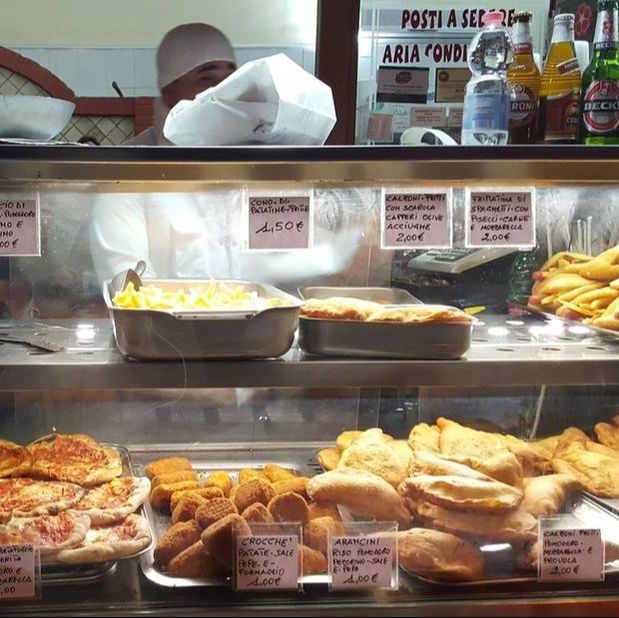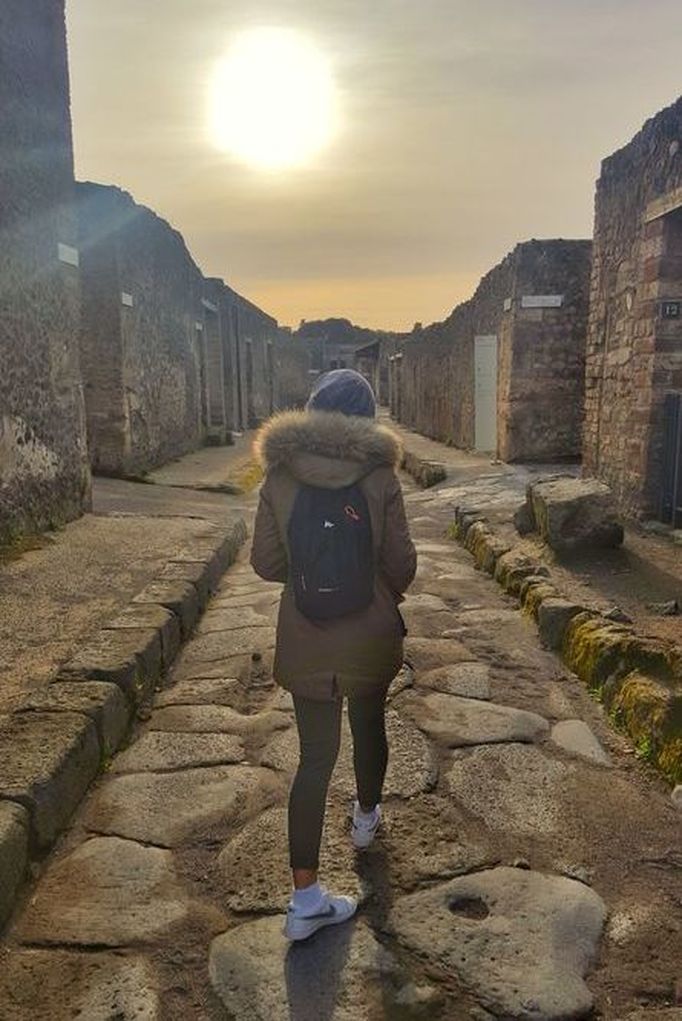|
If you’ve heard of Pompeii, chances are your mind is quickly associating it to the infamous volcanic eruption that destroyed the Pompeii city. And rightfully so, as this is pretty much the reason why so many people would flock to this Italian region. And with all its tragic backstory, it’s not a wonder that my Mom wasn’t so keen about me going, as she probably pictured a horrendous image of a sudden eruption and I might be caught in the middle of it all. And to be honest, my naturally wild imagination also had a little anxiety somewhere in the back of my mind as I arrived at the Pompeii train station of a similar possibility. “Don’t worry, the last eruption happened during World War 2,” said a local, in an attempt to make me feel better. You mean it wasn’t thousands of years ago?? I thought frantically. I arrived in Pompeii via train, and suffice to say that the train system is nowhere as fancy as others you’d find around Europe. The stations looked kind of old, and the spray-paint vandalism on the train coaches and station walls didn’t exactly help either. But what it lacks in glamour it makes up with it’s very relaxed attitude – I found that the locals were a lot more chill, and walking around the city was a relaxing affair. In any case, if Pompeii is one of your to-do list (and seriously, it should be), here are some of the top things one should look forward to when visiting. Hiking path up to the peak At the crater of Mount Vesuvius 1. Hike Mount Vesuvius Yes, it’s an amazing experience. No, it’s not spewing with lava. Mount Vesuvius is the volcano, you know, the volcano that buried Pompeii 30 meters deep with its ash. There are a lot of tours offering this hiking package, but whatever your choice is, it shouldn’t cost more than 10 euros. It’s an easy to moderate hike, depending on the weather. If it’s particularly cold, wear appropriate thermal wear and please, please, please bring gloves. It was so cold and windy on my way up that my hands felt numb and I wondered if they might just fall off like a chuck of frozen meat. Bring water, camera and some money – chances are you’d want hot tea after you’re done climbing. The view is worth all the trouble, though. You get a bird’s eye view of the whole city, and one could only imagine how far the eruption must’ve been to be able to diminish the whole city to the extent of the coastline. Clockwise from top left: Street food at bargain prices, tiramisu, fresh mozzarella, gnocchi pomodoro (potato dumplings in tomato sauce) 2. Eat, eat, and then eat again Hey, it’s Italy. What do you expect? The good news is food here is a lot cheaper compared to other European cities. If you’re on a budget, street food is abundant, from slices of warm pizza to fried risotto balls to comforting potato croches. Otherwise, there are restaurants everywhere offering reasonable dinner sets of the usual delicious suspects – pasta, pizza, risotto, seafood, and a myriad of local desserts. Speaking of which, don’t forget to indulge in their local dessert, the global-famous tiramisu or some cannoli! Back in the day, tiramisu was considered peasant food, as the locals didn’t want to waste stale bread. In any case, how awesome is it to be able to eat it at its real place of origin? Actual figures of the eruption victims, reconstructed with plaster Streets of ancient Pompeii at sunset Preserved painting at one of the mansions in the ruins area 3. Visit the Pompeii ruins What’s the point of going to Pompeii if you’re not visiting the Pompeii ruins? I’m here to tell you straight up that checking them out is definitely one for the books. Imagine a large city, once the pride of a Roman empire, buried in an instant by volcanic eruption. What happens then is that everything is preserved exactly the way it is, including the buildings, the coliseum, the people, and the monuments. You buy a whole-day pass and don’t worry, it’s really worth the money. Better yet, get yourself one of those audio guides that will explain to you everything you’re seeing. You’ll be walking in the ancient city of Pompeii, past the streets of houses, prostitute centres, markets, laundry houses, and preserved figures of the victims of the eruption. It’s eerie yet amazing at the same time, walking around the ‘dead’ city while trying to picture what life must be like back then, and how terrifying the eruption would have been. Local church, central Pompeii 4. Go to church Pompeiians love their faith, and the predominantly Christian community exhibits wonderful displays of local churches around the city. Don’t be shy and step into one of them, sit at the back and enjoy the beautiful architecture. There was a mass christening in particular when I visited, and it was quite awesome to be watching the whole procession and enjoy the hymns echoing against the beautiful painted glass and historical interior. As usual, when visiting spiritual centres, don’t be a nuisance, don’t be too loud and always be respectful of others, regardless of what your own personal views are.  Laid-back street of modern day Pompeii Lemons everywhere! 5. Learn its history
There is so much more to Pompeii than just a story of a volcanic eruption. For instance, did you know that it also houses another ancient city called Herculaneum? It is currently under reconstruction and excavation, but soon it would be open for visits. Other than that, Pompeii is a pleasant Italian city perfect if you’re looking for an excuse to bask in some history while eating a plate of pasta or two (alright, alright, I meant five). Unlike other more progressive cities in Europe, Pompeii is comparatively modest. It’s a perfect place to stop by if you’re traveling around this region, particularly if you’re looking to escape the busier Amalfi coast or the louder Napoli city. |
Archives
May 2024
Categories
All
https:/
/www.bootsoverbooks.com/
|












